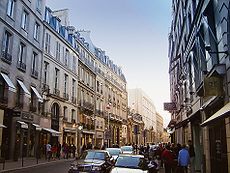Rue du Faubourg Saint Honoré

View of the street in 2005
|
|
| Length | 2,070 m (6,790 ft) |
|---|---|
| Width | 14.50 m (47.6 ft) between rue Royale and rue La Boétie; 13.80 m between rue La Boétie and avenue de Wagram |
| Arrondissement | 8th |
| Quarter | Faubourg du Roule, Madeleine |
| From | 15-19 rue Royale |
| To | 46 avenue de Wagram and 2 place des Ternes |
| Construction | |
| Denomination | December 10, 1847 |
The rue du Faubourg Saint-Honoré is a street in Paris, France. Relatively narrow and nondescript, especially in comparison to the nearby avenue des Champs Élysées, it is cited as being one of the most luxurious and fashionable streets in the world thanks to the presence of virtually every major global fashion house, the Élysée Palace (official residence of the President), the Hôtel de Pontalba (residence of the United States Ambassador to France), the residence of the Canadian Ambassador to France, the Embassy of the United Kingdom, and numerous art galleries.
The rue Saint-Honoré, of which the rue du Faubourg Saint-Honoré is now an extension, began as a road extending west from the northern edge of the Louvre Palace. Saint Honoré, Honorius of Amiens, is the French patron saint of bakers.
Until the 18th century, a few villages were dispersed in a rural area that extended west of the Louvre. The main street (a dirt road) of Roule, one of the villages, became rue Neuve-Saint-Honoré; it was lined and surrounded by a few mansions. The passage was upgraded in the 12th century to accommodate the increasing traffic from Paris's central market, Les Halles, to the outer villages. (The market was moved from the center of Paris in 1971 to the suburb Rungis.)
The road extended to the edge or gate of Paris. The passage was renamed rue du Faubourg Saint-Honoré when the village became an official suburb of Paris; (foris burgem in Latin means "outside the city."). Originally, the passage extended to the Forêt de Rouvray ("oak forest"), which covered a vast area west of Paris. Remnants of it are the Bois de Boulogne, as well as the 5 100 ha Forêt Domaniale de la Londe-Rouvray in Normandy.
...
Wikipedia

